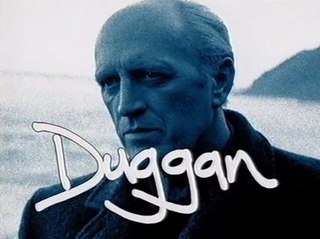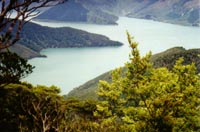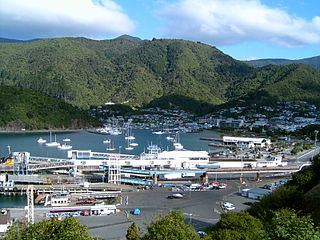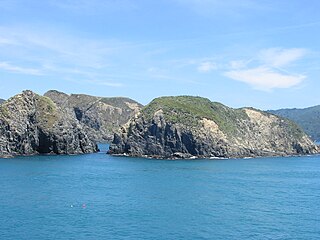 W
WThe Marlborough Sounds are an extensive network of sea-drowned valleys at the northern end of the South Island of New Zealand. The Marlborough Sounds were created by a combination of land subsidence and rising sea levels. According to Māori mythology, the sounds are the prows of the sunken wakas of Aoraki.
 W
WAnakiwa is a coastal residential village in the Marlborough region of New Zealand. It sits at the head of Queen Charlotte Sound/Tōtaranui, one of the Marlborough Sounds, 23 km (14 mi) west of Picton and 18 km (11 mi) east of Havelock. At the 2018 census, the village had a usual resident population of 171.
 W
WCape Jackson is a peninsula in Marlborough, in the South Island of New Zealand. It lies between Queen Charlotte Sound and Cook Strait.
 W
WDuggan was a TVNZ police drama from 1997, featuring New Zealand actor John Bach as Detective Inspector John Duggan and Fiona Mogridge as Ruth Duggan. Unlike other New Zealand police drama series, Duggan was initially intended to be produced as a series of one-off programmes, akin to British crime series of the time such as Inspector Morse and Midsomer Murders. Two stories were filmed in this way, one each in 1997 and 1998, before the decision was made to produce a series of 11 episodes in 1999. All episodes except for the first two were one hour in length; the first two were two hours long.
 W
WFairy Bay is east of Mount Stanley, elevation 971 metres (3,186 ft), in Pelorus Sound / Te Hoiere, part of the Marlborough Sounds Maritime Park, at the top of the South Island, New Zealand. The origin of the name is thought to have been the fairy penguin. A neighbouring bay immediately to the south is called Penguin Bay.
 W
WThe Marlborough Sounds Important Bird Areas are four distinct sites comprising several small, rocky islets contained within an area with a maximum linear extent of 40 km, in New Zealand. They lie close to Cook Strait in the outer Marlborough Sounds at the northern end of the South Island. The sites are Duffers Reef, Sentinel Rock, White Rocks and the Trio Islands. They have been identified as Important Bird Areas (IBAs) by BirdLife International because they hold the only known colonies, and encompass the entire breeding range, of the vulnerable rough-faced shag.
 W
WMS Mikhail Lermontov was an ocean liner owned by the Soviet Union's Baltic Shipping Company, built in 1972 by V.E.B. Mathias-Thesen Werft, Wismar, East Germany. It was later converted into a cruise ship. On 16 February 1986 she collided with rocks near Port Gore in the Marlborough Sounds, New Zealand, and sank, claiming the life of one of her crew members.
 W
WOutward Bound New Zealand (OBNZ) is a non-profit organisation providing experiential education in New Zealand. Its stated goal is to help participants reach their potential "through challenge in the outdoors". In total, more than fifty thousand students have attended the school.
 W
WPenzance Bay is a popular bay located in Tennyson Inlet, within the Marlborough Sounds. Tennyson Inlet is an arm of Pelorus Sound. The bay is immediately north of Tuna Bay which is accessed by the same road.
 W
WPicton is a town in the Marlborough Region of New Zealand's South Island. The town is located near the head of the Queen Charlotte Sound / Tōtaranui, 25 km (16 mi) north of Blenheim and 65 km (40 mi) west of Wellington. Waikawa lies just north-east of Picton.
 W
WTe Whanganui / Port Underwood is a sheltered harbour which forms the north-east extension of Cloudy Bay at the northeast of New Zealand's South Island, on the east coast of the Marlborough Sounds. With only a relatively narrow entrance to the south-south-east it is sheltered from almost all winds. Originally considered part of Cloudy Bay the port was named after Joseph Underwood of the shipping firm Kabel and Underwood in the early 19th century.
 W
WThe Queen Charlotte Track is a 71 km long New Zealand walking track between Queen Charlotte Sound and Kenepuru Sound in the Marlborough Sounds. It extends from Ship Cove in the north to Anakiwa in the south. For most parts, the track leads through native bush along the ridgeline of hills between the sounds, offering good views either side.
 W
WThe New Zealand king shag, also known as the rough-faced shag, king shag or kawau, is a rare bird endemic to New Zealand. Some taxonomic authorities, including the International Ornithologists' Union, place this species in the genus Leucocarbo. Others place it in the genus Phalacrocorax.
 W
WMeretoto / Ship Cove is a small bay in the Marlborough Region of New Zealand, renowned as the first place of prolonged contact between Māori and Europeans. It is located near the entrance of Queen Charlotte Sound / Tōtaranui, west of nearby Motuara Island and Long Island.
 W
WThe Stephens Island / Takapourewa lighthouse is one of New Zealand most powerful lights with a range of 18 nautical miles. Perched 183 metres (600 ft) up, on top of Stephens Island, it guards Cook Strait and Tasman Bay, at the top of the South Island / Te Wai Pounamu.The light flashes white once every six seconds from a white cast iron tower.
 W
WWaikawa is a small settlement to the north east of Picton, Marlborough, New Zealand. Waikawa Bay opens onto Queen Charlotte Sound.
 W
WWest Head is the name of three separate headlands on New Zealand's South Island.43°40′38″S 173°04′20″E, at the entrance to Okains Bay on Banks Peninsula. 41°13′02″S 174°08′37″E, at the end of a peninsula on the northern shore of Queen Charlotte Sound. 41°12′57″S 174°18′55″E, a rocky headland at the entrance to Tory Channel.
 W
WLyall's wren or the Stephens Island wren was a small flightless passerine belonging to the family Acanthisittidae, the New Zealand wrens. It was once found throughout New Zealand, but when it came to the attention of scientists in 1894, its last refuge was Stephens Island in Cook Strait. Often claimed to be a species driven extinct by a single creature, the wren in fact fell victim to the island's numerous feral cats. The wren was described almost simultaneously by both Walter Rothschild and Walter Buller. It became extinct shortly after.